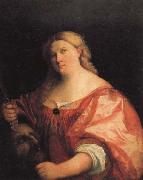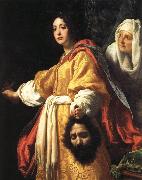
Oil On
Canvas, Real Flavor of Old Masters
|
Lucas Cranach
|
|||
|
|
|||
| 1472-1553 German Lucas Cranach Locations Lucas Cranach the Elder was born at Kronach, Franconia. He was apparently trained by his father, Hans, a painter, and from 1495 to 1498 undertook work at Kronach for Coburg and Gotha. There is evidence that Cranach resided in Vienna between about 1500 and 1504. In 1504 he married Barbara Brengbier of Gotha; they had three daughters and two sons, Hans (died 1537) and Lucas the Younger (1515-1586), both of whom were painters. In 1505 Cranach established residence at Wittenberg, where he was court painter to three successive electors: Frederick the Wise, John the Constant, and John Frederick the Magnanimous. Cranach was a prosperous and respected citizen. He owned several houses and land, held the office of councilor, and was a burgomaster. He also worked for other princely patrons and was a follower and lifelong friend of Martin Luther. In 1550 Cranach followed John Frederick the Magnanimous to Augsburg, where the elector was in exile, and in 1552 accompanied him to Weimar. Cranach died in Weimar on Oct. 16, 1553. | |||
|
|
|||
|
|
Judith with the Head of Holofernes Lucas Cranach18.jpg Painting ID:: 659 Visit European Gallery |
1530 Art History Museum, Vienna | |
Height Width |
INS/CM |
||
|
X |
|
||
|
|
|||
|
Palma Vecchio
|
|||
|
|
|||
| 1480-1528 Italian Palma Vecchio Gallery His birthdate is calculated on Vasari testimony (1550) that he died aged 48. By March 1510 he was in Venice, where he spent his working life. The stylistic evidence of his earliest works suggests that he was apprenticed to fellow Bergamasque artist Andrea Previtali, who had studied under Giovanni Bellini. A signed Virgin Reading (1508-10; Berlin, Gemeldegal.), which may be Palma Vecchio earliest surviving painting, is strongly reminiscent of his teacher. Previtali returned to Bergamo in 1511, and the main corpus of Palma work can be dated from this time. Palma Vecchio oeuvre reflects the change from an early to a high Renaissance conception of the human figure in secular and religious art. He specialized in certain themes that became established in the repertory of genres of the Venetian school in the generation after him. The principal of these were the wide-format SACRA CONVERSAZIONE | |||
|
|
|||
|
|
Judith with the Head of Holofernes new3/Palma Vecchio-475773.jpg Painting ID:: 28972 Visit European Gallery |
mk65 Panel 35 7/16x27 15/16in Uffizi | |
Height Width |
INS/CM |
||
|
X |
|
||
|
|
|||
|
Cristofano Allori
|
|||
|
|
|||
| Italian Baroque Era Painter, 1577-1621 was an Italian portrait painter of the late Florentine Mannerist school. Allori was born at Florence and received his first lessons in painting from his father, Alessandro Allori, but becoming dissatisfied with the hard anatomical drawing and cold coloring of the latter, he entered the studio of Gregorio Pagani (1558-1605) who was one of the leaders of the late Florentine school, which sought to unite the rich coloring of the Venetians with the Florentine attention to drawing. Allori also appears to have worked under Cigoli. His pictures are distinguished by their close adherence to nature and the delicacy and technical perfection of their execution. His technical skill is shown by the fact that several copies he made of Correggio's works were thought to be duplicates by Correggio himself. His extreme fastidiousness limited the number of his works. Several specimens are to be seen at Florence and elsewhere. The finest of his works is his Judith with the Head of Holofernes. It exists in two copies in the Pitti Palace in Florence and in the Queen's Gallery in London. | |||
|
|
|||
|
|
Judith with the Head of Holofernes new3/Cristofano Allori-362962.jpg Painting ID:: 29956 Visit European Gallery |
mk67 Oil on canvas 54 3/4x45 11/16in Pitti,Palatine Gallery | |
Height Width |
INS/CM |
||
|
X |
|
||
|
|
|||
|
Peter Paul Rubens
|
|||
|
|
|||
| Flemish Baroque Era Painter, 1577-1640 Peter Paul Rubens (June 28, 1577 ?C May 30, 1640) was a prolific seventeenth-century Flemish Baroque painter, and a proponent of an exuberant Baroque style that emphasized movement, color, and sensuality. He is well-known for his Counter-Reformation altarpieces, portraits, landscapes, and history paintings of mythological and allegorical subjects. In addition to running a large studio in Antwerp which produced paintings popular with nobility and art collectors throughout Europe, Rubens was a classically-educated humanist scholar, art collector, and diplomat who was knighted by both Philip IV, king of Spain, and Charles I, king of England. Rubens was a prolific artist. His commissioned works were mostly religious subjects, "history" paintings, which included mythological subjects, and hunt scenes. He painted portraits, especially of friends, and self-portraits, and in later life painted several landscapes. Rubens designed tapestries and prints, as well as his own house. He also oversaw the ephemeral decorations of the Joyous Entry into Antwerp by the Cardinal-Infante Ferdinand in 1635. His drawings are mostly extremely forceful but not detailed; he also made great use of oil sketches as preparatory studies. He was one of the last major artists to make consistent use of wooden panels as a support medium, even for very large works, but he used canvas as well, especially when the work needed to be sent a long distance. For altarpieces he sometimes painted on slate to reduce reflection problems. His fondness of painting full-figured women gave rise to the terms 'Rubensian' or 'Rubenesque' for plus-sized women. The term 'Rubensiaans' is also commonly used in Dutch to denote such women. | |||
|
|
|||
|
|
Judith with the Head of Holofernes new3/Peter Paul Rubens-559272.jpg Painting ID:: 30015 Visit European Gallery |
mk67 Oil on canvas 44 1/2x35in Uffizi,Gallery | |
Height Width |
INS/CM |
||
|
X |
|
||
|
|
|||










